- Home
- About Journals
-
Information for Authors/ReviewersEditorial Policies
Publication Fee
Publication Cycle - Process Flowchart
Online Manuscript Submission and Tracking System
Publishing Ethics and Rectitude
Authorship
Author Benefits
Reviewer Guidelines
Guest Editor Guidelines
Peer Review Workflow
Quick Track Option
Copyediting Services
Bentham Open Membership
Bentham Open Advisory Board
Archiving Policies
Fabricating and Stating False Information
Post Publication Discussions and Corrections
Editorial Management
Advertise With Us
Funding Agencies
Rate List
Kudos
General FAQs
Special Fee Waivers and Discounts
- Contact
- Help
- About Us
- Search

The Open Paleontology Journal
(Discontinued)
ISSN: 1874-4257 ― Volume 5, 2014
Mesoproterozoic Calymmian Tintinnids from Central China
You-Xing Li*, 1 , Su-Xin Zhang2, Jie Zhang3
Abstract
Tintinnids are very common in all marine water and even fresh water. The oldest fossils of Tintinnids are not only appeared in Neoproterozoic Era, but also in Mesoproterozoic Calymmian. Eight species of six genera Tintinnids of Mesoproterozoic Calymmian, from Huangmailing Phosphoric Ore in Hubei Province of Central China, are illustrated in this paper. They are the oldest ancestor of Tintinnids. Tintinnids had about 1600 million years history
Article Information
Identifiers and Pagination:
Year: 2009Volume: 2
First Page: 10
Last Page: 13
Publisher Id: TOPALOJ-2-10
DOI: 10.2174/1874425700902010010
Article History:
Received Date: 4/3/2009Revision Received Date: 29/5/2009
Acceptance Date: 2/6/2009
Electronic publication date: 18 /6/2009
Collection year: 2009
open-access license: This is an open access article distributed under the terms of the Creative Commons Attribution License (http://creativecommons.org/licenses/by/2.5/), which permits unrestrictive use, distribution, and reproduction in any medium, provided the original work is properly cited.
* Address correspondence to this author at the Key Laboratory of Biogeology and Environmental Geology, Ministry of Education, China University of Geosciences, Wuhan Institute of Technology, Wuhan 430073, China; E-mail: youxingli@hotmail.com
| Open Peer Review Details | |||
|---|---|---|---|
| Manuscript submitted on 4-3-2009 |
Original Manuscript | Mesoproterozoic Calymmian Tintinnids from Central China | |
Tintinnids are important members of the plankton in all marine habitats, and some of them also can live in the fresh water nowadays [1-13]. But very few of them had been preserved as fossils in the rocks. The fossils of Tintinnids had been reported by paleontologists that was appeared as early as the Neoproterozoic Era and were very common in Late Jurassic and Early Cretaceous Period [14-17]. In 2006, we reported that Funnela sinensis [18], the oldest fossil of Tintinnids in the rocks of the lower part of Huangmailing Formation of Mesoproterozoic (about 1600 million years ago). Here, the aim of this study is to report on the Tintinnids more detail in the metamorphic rocks of Huangmailing Formation from Huangmailing phosphoric Ore in Hubei Province of Central China. Eight species of Tintinnids are illustrated with scanning electron micrographs here. Tintinnids samples for species identification were collected from the metamorphic rocks of the seven Geological Sections of Huangmailing Phosphoric Ore: the fourth bed of granulitite and the fifth bed of granulitic apatitolite of Section A; the fifth bed of granulitite and the sixth bed of granulitic apatitolite of Section B; the fourth bed of leucoleptite, the seventh bed of granulitite, the ninth bed of granulitite and the eleventh bed of gneiss of Section D; the first bed of leucoleptite of Section E; the first bed of granulitite, the sixth bed of granulitic apatitolite and the seventh bed of leucoleptic apatitolite of Section F; the fourth bed of leucoleptite, the sixth bed of leucoleptic apatitolite, the eighth bed of leucoleptic apatitolite and the ninth bed of granulitic apatitolite of Section G; and the third bed of leucoleptite and the fourth bed of leucoleptic apatitolite of Section H (Fig. 1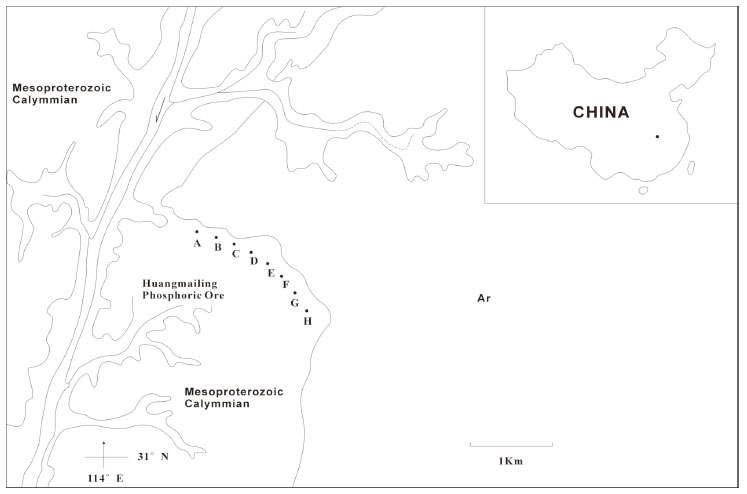 ).
).
 |
Fig. (1) Map showing location of ailing Phosphoric Ore, and all specimens discussed in this paper were found at localities A, B, C, D, E, F, G and H. |
GEOLOGICAL SECTION OF HUANGMAILING PHOSPHORIC ORE
Huangmailing Formation
Section G
Section G is the main section which yielding a lot of fossils. It is located at Dajian hill.
Bed 12 2.5m. Dark grey granulitite, yielding Tubular fossils.
Bed 11 2.2m. Black granulitite, yielding Tintinnids Eutintinnus tubulosus, E. frakmoi and Tubular fossils.
Bed 10 1.3m. Striped granulitite, yielding Tubular fossils.
Bed 9 2.3m. Dark grey granulitic aputitolite, yielding Tintinnids Eutintinnus tubulosus, Funnela sinensis, Salpingella acuminata, Undella bicollaria and Tubular fossils.
Bed 8 2.1m. Grey leucoleptite, yielding Tubular fossils.
Bed 7 0.8m. Black grey leucoleptic apatitolite, yielding Tubular fossils.
Bed 6 2.0m. Dark grey granulitite, yielding Tubular fossils.
Bed 5 0.4m. Black stripedgranulitic apatitolite, yielding Tintinnids Eutintinnus tubulosus, Salpingella acuminata and Tubular fossils.
Bed 4 5.1m. Dark grey granulitite, yielding Tintinnids Eutintinnus tubulosus, Funnela sinensis, Tintinnopsis coronata, Salpingella acuminata and Tubular fossils.
Bed 3 0.2m. Striped granulitite, yielding Tintinnids Undella bicollaria, Xystonellopsis brandti and Tubular fossils.
Bed 2 2.7m. Grey leucoleptic apatitolite, yielding Tintinnids Eutintinnus frakmoi, Tintinnopsis coronata and Globule Sinosphaera hubeiensis and Tubular fossils.
Bed 1 0.45m. Black manganese apatitolite, yielding Globule Sinosphaera hubeiensis and Tubular fossils.
︿︿︿︿︿ Unconformity ︿︿︿︿︿
The underlying bed: grey archaeozoic era gneiss.
A total of eight Tintinnid species belong to six genera and four families were identified. They are Eutintinnus lusus-undae (Fig. 2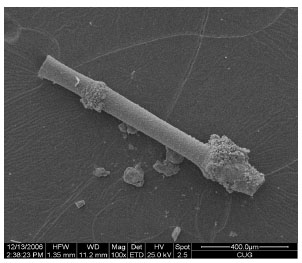 ), E. fraknoi (Fig. 9
), E. fraknoi (Fig. 9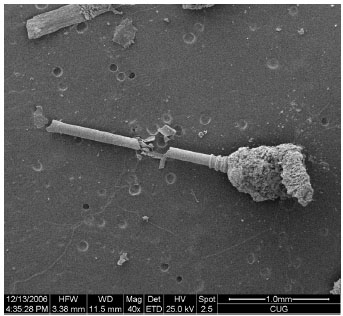 ) and E. tubulosus (Fig. 3
) and E. tubulosus (Fig. 3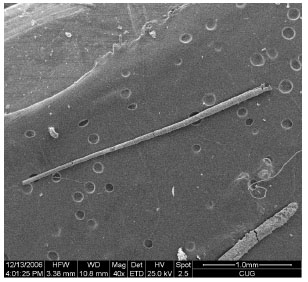 ) of Genus Eutintinnus of Family Tintinnidae, and Funnela sinensis (Fig. 4
) of Genus Eutintinnus of Family Tintinnidae, and Funnela sinensis (Fig. 4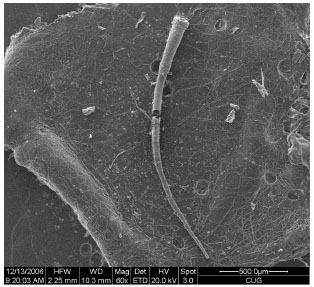 ) of Genus Funnela and Salpingella acuminata (Fig. 5
) of Genus Funnela and Salpingella acuminata (Fig. 5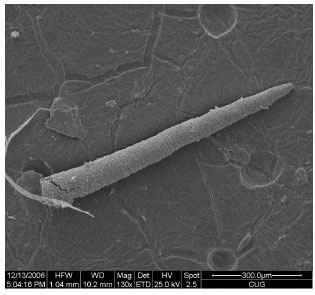 ) of Genus Salpingella of Tintinnidae too; Xystonellopsis brandti (Fig. 6
) of Genus Salpingella of Tintinnidae too; Xystonellopsis brandti (Fig. 6 ) of Genus Xystonellopsis of Family Xystonellidae; Tintinnopsis coronata (Fig. 7
) of Genus Xystonellopsis of Family Xystonellidae; Tintinnopsis coronata (Fig. 7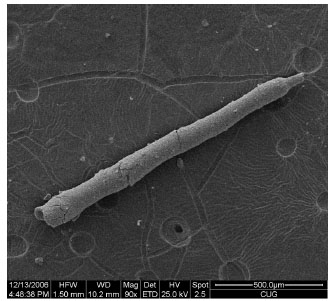 ) of Genus Tintinnopsis of Family Codonellidae; and Undella bicollaria (Fig. 8
) of Genus Tintinnopsis of Family Codonellidae; and Undella bicollaria (Fig. 8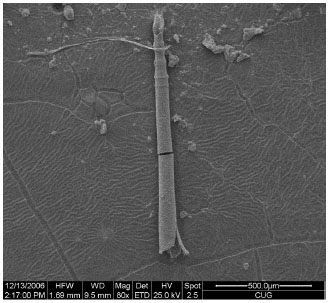 ) of Genus Undella of Family Undellidae.
) of Genus Undella of Family Undellidae.
 |
Fig. (2) Eutintinnus lusus-undae Entz, 1885. Fossil was collected from the ninth bed of granulitite of Section D. |
 |
Fig. (9) Eutintinnus frakmoi (Daday) Kofoid & Campbell, 1939. Fossil was collected from the ninth bed of granulitite of Section D. |
 |
Fig. (3) Eutintinnus tubulosus (Ostenfeld) Kofoid & Campbell 1939. Fossil was collected from the fourth bed of leucoleptite of Section G. |
 |
Fig. (4) Funnela sinensis Li & Zhang, 2006. Fossil was Collected from the ninth bed of granulitic apatitolite of Section G. |
 |
Fig. (5) Salpingella acuminata Kofoid & Campbell, 1929. Fossil was collected from the fourth bed of leucoleptite of Section G. |
 |
Fig. (6) Xystonellopsis brandti (Laackmann) Jörgensen, 1924. Fossil was collected from the fourth bed of leucoleptic apatitolite of Section H. |
 |
Fig. (7) Tintinnopsis coronata Kofoid & Campbell, 1929. Fossil was collected from the fourth bed of leucoleptic apatitolite of Section H. |
 |
Fig. (8) Undella bicollaria Brandt, 1906. Fossil was collected from the ninth bed of granulitic apatitolite of Section G. |
EOECOLOGY
All Tintinnid fossils are calcareous samples. The size of minerals, in gneiss, leucoleptic apatitolite, granulitite, granulitic apatitolite and leucoleptite of which contain Tintinnids, are from 0.02 mm to 0.3 mm in Huangmailing region. That is belong to the silt range. These rocks also contain the same size of pyrites. Tintinnids Xystonellopsis, Undella and Funnela were lived in Sea Basin or Deep under-water [4, 19]. According to these above characters, we are sure that Tintinnids, from Huangmailing Phosphoric Ore of Central China, were lived in the sea basin of anoxic environment in Mesoproterozoic Calymmian.
CONCLUSION
These six genera, Funnela, Eutintinnus, Salpingella, Xystonellopsis, Tintinnopsis and Undella, are the oldest ancestor of Tintinnids. They were lived in sea basin in Mesoproterozoic Calymmian at Huangmailing region of Hubei Province of Central China. Tintinnids had near 1600 million years history.
ACKNOWLEDGEMENTS
The research was carried out under the auspices of an award from the Key Laboratory of Biogeology and Environmental Geology (CUG), Ministry of Eduction. The field work in Huangmailing Phosphoric Ore was supplied by Engineer Ang Ren. Special thanks are due to Professor Jinnan Tong for he gave important information about the research.
